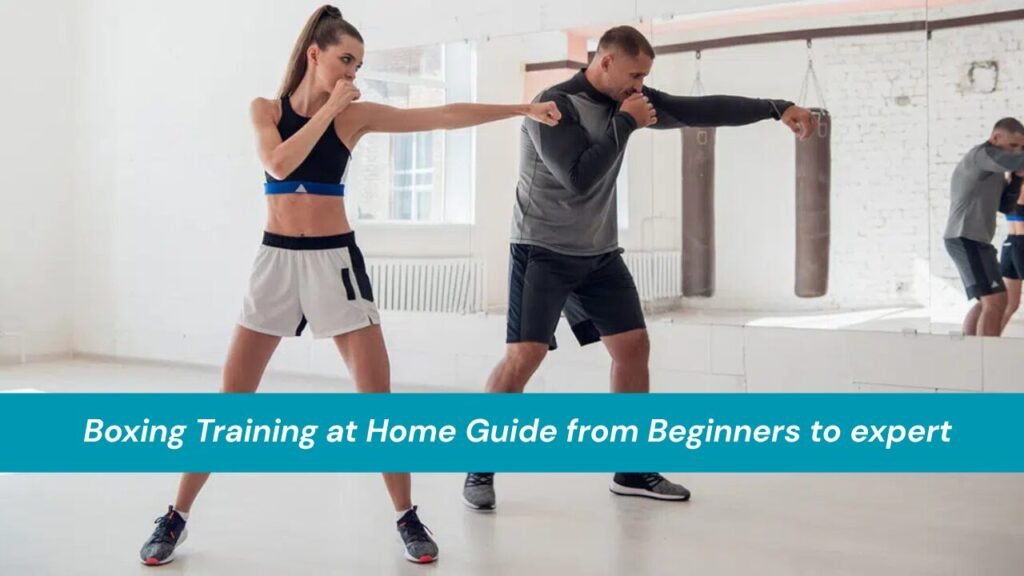Boxing training at home has become a popular fitness trend, offering a powerful full-body workout while developing essential self-defense skills. Whether you’re looking to get fit, learn a new skill, or train for a competition, boxing is an effective workout that delivers both mental and physical benefits. The best part? You don’t have to go to a gym to get started. With just a few basic pieces of equipment, you can practice boxing in the comfort of your home.
This comprehensive guide will walk you through the essentials of boxing training at home, including equipment, training drills, tips for beginners, and advanced techniques for experienced athletes. By the end of this guide, you’ll have a clear understanding of how to train effectively at home, regardless of your skill level.
Why Choose Boxing Training at Home?
Training at home offers several advantages, making it an ideal option for those who prefer working out in a private space or on a flexible schedule. Here are a few reasons why boxing at home could be a game-changer: Convenience: With boxing training at home, you can skip the hassle of commuting to a gym and train whenever you have free time. Cost-Effective: There’s no need for expensive gym memberships or personal trainers. After an initial investment in equipment, the rest of your training is free. Privacy: If you feel self-conscious in a gym environment, boxing at home offers a private setting where you can practice without feeling judged. Customization: You have the freedom to tailor your training to meet your personal fitness goals, whether it’s weight loss, conditioning, or improving boxing skills. Flexibility: You control when and how often you train, allowing you to fit your workouts into your busy schedule without needing to work around a gym’s hours.
Setting Up for Boxing Training at Home
Essential Equipment for Boxing Training at Home
While boxing can be done with minimal equipment, there are a few essentials that will help you train effectively and safely: Boxing Gloves: Boxing gloves are crucial for protecting your hands and wrists when hitting a heavy bag. They also provide support during training to prevent injuries. Heavy Bag: A heavy bag is one of the most important tools for a boxer. It allows you to practice punches with resistance, which builds power and endurance. If space or budget is a concern, a hanging punching bag or freestanding bag can be a great alternative. Speed Bag: A speed bag is used to develop rhythm, hand-eye coordination, and punch accuracy. This piece of equipment is particularly useful for advanced athletes. Hand Wraps: Hand wraps are important for providing support and protection to the wrists and knuckles. They should be worn under gloves to prevent injuries during intense training. Jump Rope: Jumping rope is an excellent cardio exercise that helps with footwork, coordination, and conditioning. It’s a staple in boxing training. Mirror: Having a mirror in your training area allows you to check your form and improve your technique. This is especially useful for beginners learning basic boxing stances and punches.
Choosing the Right Space
When it comes to setting up your home gym, choose a space that allows you to move freely without obstacles. Ideally, you should have enough room to practice punches and footwork. A small area, such as a garage or living room, can work just fine. If you’re using a heavy bag, make sure there is enough space for it to swing without hitting anything. Keep the area clean and organized to avoid any distractions or injuries during your workout.
Boxing Drills You Can Do at Home
Once your equipment and space are set up, it’s time to dive into training. Here are several effective boxing drills that can be done at home, whether you’re a beginner or an advanced athlete.
Shadow Boxing
Shadow boxing is one of the most fundamental drills in boxing. It involves practicing your punches, movement, and footwork without a physical target. This exercise helps you develop muscle memory, improve your technique, and increase speed and agility. Start by standing in front of a mirror and imagining an opponent in front of you. Practice jabs, crosses, hooks, and uppercuts, while incorporating different combinations. Focus on maintaining proper form, shifting your weight, and keeping your hands up for protection.
Heavy Bag Workouts
A heavy bag is an essential tool for practicing power punches and combinations. It gives you the resistance needed to build strength and endurance. To get started, begin with basic combinations like jab-cross-hook, jab-cross-uppercut, and work on your timing and power. As you progress, you can increase the intensity and complexity of your combinations. Aim for longer rounds, but take breaks in between to avoid overexertion. Remember to focus on proper technique, including footwork, when working with the bag.
Jump Rope for Conditioning
Jump rope is an excellent cardio exercise that improves footwork, coordination, and overall conditioning. Boxers use jump ropes to build stamina and develop rhythm. It’s also a great way to warm up before your boxing training. Start by jumping for 2-3 minutes continuously, then rest for a minute before repeating. As you get more comfortable, increase the duration and intensity of your jump rope workouts. Try alternating between single jumps, double unders, and crisscross jumps to add variety to your workout.
Footwork Drills
Good footwork is essential for effective boxing. Without proper footwork, even the strongest punches won’t land effectively. To improve your footwork, practice moving in all directions forward, backward, and side-to-side. Set up cones or markers and practice moving around them, staying light on your feet. You can also practice pivoting, where you shift your weight to one foot and rotate your body to face a new direction.
Punching Combinations
Punching combinations are key to both offense and defense in boxing. Learn to string together different punches in quick succession. Common combinations include jab-cross, jab-cross-hook, jab-cross-uppercut, and jab-hook-cross. Start slowly and focus on your form. Once you’ve mastered the combinations, increase your speed and power while maintaining proper technique.
Training Tips for Beginners
If you’re new to boxing, it’s important to build a strong foundation before progressing to more advanced training. Here are some tips for beginners: Start Slow and Build Gradually It’s tempting to jump right into intense workouts, but it’s important to take your time and focus on building proper technique. Start with basic drills, and don’t rush your progress. Focus on mastering the fundamentals of footwork, punches, and defense. Listen to Your Body Boxing can be physically demanding, so it’s crucial to listen to your body. Take rest days when needed, and if you experience any pain or discomfort, don’t push through it. Pay attention to your body’s signals to avoid injury. Consistency is Key Like any workout routine, consistency is essential. Aim to train regularly, whether it’s 3-4 days a week or daily, depending on your fitness level. Even short, consistent sessions will yield results over time. Warm Up and Cool Down Before each workout, warm up your muscles with light cardio or dynamic stretching. After your training session, take time to cool down and stretch to improve flexibility and prevent injuries.
Advanced Boxing Techniques for Home Training
If you’ve mastered the basics, you can start incorporating advanced boxing drills to take your training to the next level. Here are a few ideas: Interval Training Interval training involves alternating between high-intensity work and low-intensity recovery periods. For example, you could do 30 seconds of intense punching combinations followed by 30 seconds of rest. This helps improve your stamina and conditioning. Circuit Training Circuit training involves combining different exercises into a sequence. You could combine shadow boxing, heavy bag work, jump rope, and bodyweight exercises (like push-ups or squats) to create a high-intensity full-body workout. Virtual Sparring or Partner Sparring If you have a training partner or access to virtual sparring platforms, sparring can provide an excellent simulation of real-life boxing. Sparring helps develop timing, reflexes, and strategy.
Common Mistakes to Avoid in Boxing Training at Home
To ensure you’re getting the most out of your boxing training, avoid these common mistakes: Neglecting Proper Form Many beginners rush into boxing without paying enough attention to their form. Poor technique can lead to ineffective training and injury. Always focus on your posture, footwork, and punch technique. Overtraining While boxing is a great workout, it’s important to avoid overtraining. Give your body time to recover, and don’t push yourself too hard, especially in the beginning. Rest days are just as important as training days. Skipping Warm-Ups and Cool Downs Warming up before your workout and cooling down afterward is crucial for preventing injuries and improving your performance. Skipping these steps can lead to stiffness and soreness. Not Using Protective Gear Boxing involves high-impact movements, so always wear gloves, hand wraps, and appropriate footwear to protect yourself from injury. Skipping protective gear can result in bruises, sprains, or even fractures.
FAQs
How long should I train boxing at home each day?
For beginners, aim for 20–30 minutes of boxing training per session. As you progress, you can gradually increase the duration and intensity.
Do I need a heavy bag to train at home?
A heavy bag is useful, but not essential. Beginners can start with shadow boxing, jump rope, and footwork drills before investing in a heavy bag.
Can I lose weight by doing boxing training at home?
Yes, boxing is a great cardiovascular workout that can help you burn calories and lose weight. Combined with a balanced diet, it’s an effective way to achieve fitness goals.
How do I improve my boxing technique at home?
Focus on practicing shadow boxing in front of a mirror, recording your sessions to analyze form, and gradually increasing the difficulty of your drills.
Conclusion
Boxing training at home offers an excellent way to build strength, improve cardiovascular health, and learn self-defense techniques. With the right equipment, space, and dedication, you can make significant progress without stepping foot in a gym. Whether you’re a beginner or an advanced athlete, there are plenty of ways to tailor your training to meet your goals. By staying consistent, listening to your body, and continually challenging yourself, you can achieve great results from your home boxing workouts.
Ready to get started? Grab your gloves, set up your space, and begin your boxing journey today!




